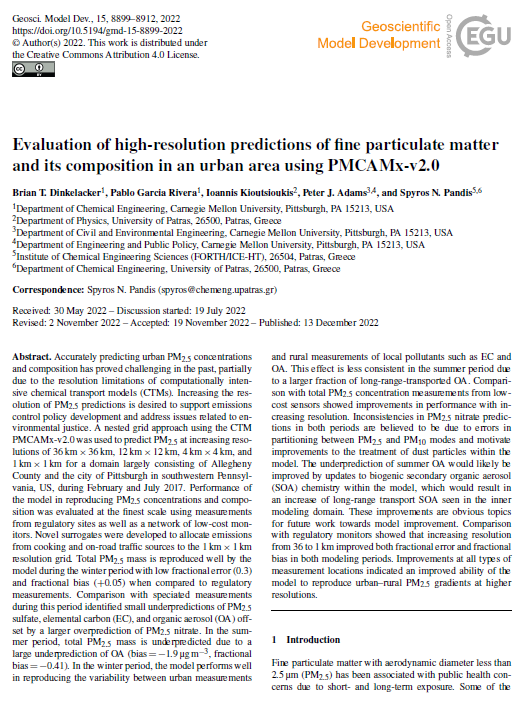Publication on Geoscientific Model Development
Evaluation of high-resolution predictions of fine particulate matter and its composition in an urban area using PMCAMx-v2.0
Authors: Brian T. Dinkelacker, Pablo Garcia Rivera, Ioannis Kioutsioukis, Peter J. Adams, Spyros Pandis
Accurately predicting urban PM2.5 concentrations and composition has proved challenging in the past, partially due to the resolution limitations of computationally intensive chemical transport models (CTMs). Increasing the resolution of PM2.5 predictions is desired to support emissions control policy development and address issues related to environmental justice. A nested grid approach using the CTM PMCAMx-v2.0 was used to predict PM2.5 at increasing resolutions of 36 km × 36 km, 12 km × 12 km, 4 km × 4 km, and 1 km × 1 km for a domain largely consisting of Allegheny County and the city of Pittsburgh in southwestern Pennsylvania, US, during February and July 2017. Performance of the model in reproducing PM2.5 concentrations and composition was evaluated at the finest scale using measurements from regulatory sites as well as a network of low-cost monitors. Novel surrogates were developed to allocate emissions from cooking and on-road traffic sources to the 1 km × 1 km resolution grid. Total PM2.5 mass is reproduced well by the model during the winter period with low fractional error (0.3) and fractional bias (+0.05) when compared to regulatory measurements. Comparison with speciated measurements during this period identified small underpredictions of PM2.5 sulfate, elemental carbon (EC), and organic aerosol (OA) offset by a larger overprediction of PM2.5 nitrate. In the summer period, total PM2.5 mass is underpredicted due to a large underprediction of OA (bias = −1.9 µg m−3, fractional bias = −0.41). In the winter period, the model performs well in reproducing the variability between urban measurements and rural measurements of local pollutants such as EC and OA. This effect is less consistent in the summer period due to a larger fraction of long-range-transported OA. Comparison with total PM2.5 concentration measurements from low-cost sensors showed improvements in performance with increasing resolution. Inconsistencies in PM2.5 nitrate predictions in both periods are believed to be due to errors in partitioning between PM2.5 and PM10 modes and motivate improvements to the treatment of dust particles within the model. The underprediction of summer OA would likely be improved by updates to biogenic secondary organic aerosol (SOA) chemistry within the model, which would result in an increase of long-range transport SOA seen in the inner modeling domain. These improvements are obvious topics for future work towards model improvement. Comparison with regulatory monitors showed that increasing resolution from 36 to 1 km improved both fractional error and fractional bias in both modeling periods. Improvements at all types of measurement locations indicated an improved ability of the model to reproduce urban–rural PM2.5 gradients at higher resolutions.
This work was supported by the Center for Air, Climate, and Energy Solutions (CACES), which was supported under assistance agreement no. R835873 awarded by the U.S. Environmental Protection Agency and the Horizon 2020 REMEDIA project of the European Union (grant no. 874753).

